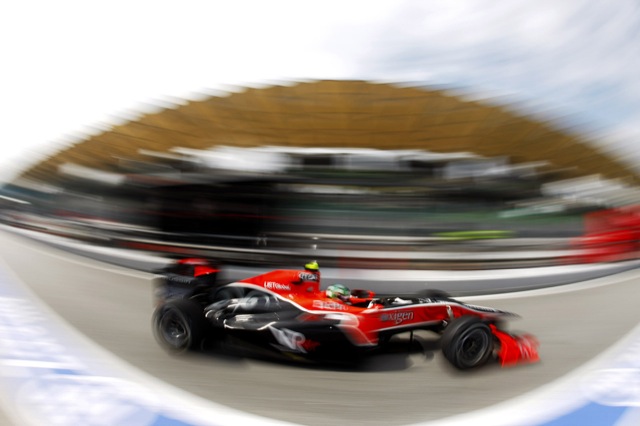Ferrari traditionally launch quite early in comparison to their rivals, and 2010 was no exception, the Maranello squad unveiling their machine ahead of everybody else. In a simple ceremony at the team’s headquarters in Northern Italy, the F10 was shown to the world and due to be shaken down at the test track enclosed within the marque’s impressive facility. However, poor weather meant that the first time drivers Felipe Massa and Fernando Alonso were able to get to grips with the new challenger was at the first group test in Valencia a few days later.
All eyes descended on the F10 because, after a fairly torrid year in 2009, the team are hoping to readdress the balance and return to the top. The F10 is Ferrari’s 56th single seater race car and was designed by Aldo Costa. In comparison to its predecessor, the F60, the F10 appears longer, possibly to help with the larger fuel tank needed due to the prohibition of refuelling during grands prix.
Perhaps the most notable change is the livery, which heralds back to a time when Marlboro adorned the cars. When tobacco advertising was outlawed, all other teams looked elsewhere for sponsorship, but Ferrari continued with their relationship with Philip Morris, and the barcode became infamous, flanked over the engine cover and rear wing. In time, the level of promotion decreased as did the amount of whitespace. In 2007, Ferrari made a final change in the tone of the red and the Ferrari cars had pretty much returned to their traditional deep red shade. However, with Fernando Alonso joining the team, Santander are now a major sponsor of the team, and with their corporate colours being red and white, the F10 has seen Ferrari adopt more white in the livery again, and perhaps a change towards Rosso Corsa once again.*
Personally, I do not like the new livery and feel that Ferrari, a team so synonymous with the sport and the traditions that go with it, should remain red. Simply, red. However, the livery doesn’t make the car go faster, so what else appears different on the new challenger. Well, aside from the length, the front end has received a fair amount of work, with the nose and wing undergoing some cosmetic surgery. The nose appears to have a Newey-dip in it as the line moves back towards the monocoque, and the front wing has received some extra bits to help channel air towards all the right places.
The sidepods appear to be slightly smaller than what we saw on the F60, but in comparison to others that have since launched, Ferrari are still not quite as efficient in the cooling department. Smaller, tighter air-intakes imply a car that is working well with its cooling, and McLaren are perhaps among the best at achieving this. Aside from this though, it is clear the F10 is an evolution of the F60 and was not designed from scratch. This usually means a steady improvement in performance and suggests that the F60 was running well towards the end of the 2009 season. And looking at Kimi Raikkonen’s results from last year, most of his haul were collected in the latter half, adding weight to the theory that the F10 should run well this year. The only possible fly in the ointment is if a team takes the other approach – a clean-slate design – and gets it spot on from the word go. But then, how often does that happen…?
Ferrari’s car designation system refers to the team name, Ferrari, and a year-based numbering system that for 2010, is 10. Hence, F10. Last year, the car was named in honour of the company’s 60th anniversary of motor sport competition and was titled the F60. Previous to that, the cars were generally designated by the letter F and the year in full, hence F2008. Ferrari are the sport’s oldest team though, and they have used many different designation systems over the years.
*It is hard to tell the shade from the studio shots supplied, but it does appear a little brighter than the F2008 and F60.
























Add comment